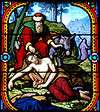Parable of the Leaven

The Parable of the Leaven (also called the Parable of the yeast) is one of the shortest parables of Jesus. It appears in Matthew (Matthew 13:33) and Luke (Luke 13:20–21). In both places it immediately follows the Parable of the Mustard Seed, which shares this parable's theme of the Kingdom of Heaven growing from small beginnings.
Narrative
The parable describes what happens when a woman adds leaven (old, fermented dough[1] usually containing lactobacillus and yeast) to a large quantity of flour (about 8½ gallons or 38 litres[2]). The living organisms in the leaven grow overnight, so that by morning the entire quantity of dough has been affected.[1]
In the Gospel of Luke, the parable is as follows:
And again he said, Whereunto shall I liken the kingdom of God? It is like leaven, which a woman took and hid in three measures of meal, till the whole was leavened.— Luke 13:20–21, KJV
Interpretation
This parable is part of a pair,[3] and shares the meaning of the preceding Parable of the Mustard Seed, namely the powerful growth of the Kingdom of God from small beginnings.[1] The final outcome is inevitable once the natural process of growth has begun.[2]
Although leaven symbolises evil influences elsewhere in the New Testament (as in Luke Luke 12:1),[1] it is not generally interpreted that way in this parable.[1][2][3][4][5][6] However, a few commentators do see the leaven as reflecting future corrupting influences in the Church.[7]
As with the Parable of the Lost Coin, this parable is part of a pair, in which the first parable describes Jesus' work in terms of a man's agricultural activities, and the second in terms of a woman's domestic activities.[3] Joel B. Green writes that Jesus "asks people — male or female, privileged or peasant, it does not matter — to enter the domain of a first-century woman and household cook in order to gain perspective on the domain of God."[4]
The large quantity of flour may hint at a planned festive occasion, since the bread produced could feed a hundred people.[3] Three measures of meal was the amount used by Sarah to bake bread when she and Abram were visited by Melchizedek and the angels. It is also the amount used in baking the shewbread for the Temple of the Lord in Israel.
See also
References
| Wikimedia Commons has media related to The Leaven. |
- 1 2 3 4 5 I. Howard Marshall, The Gospel of Luke: A commentary on the Greek text, Eerdmans, 1978, ISBN 0-8028-3512-0, pp. 561–562.
- 1 2 3 John Nolland, The Gospel of Matthew: A commentary on the Greek text, Eerdmans, 2005, ISBN 0-8028-2389-0, p. 553–554.
- 1 2 3 4 Ben Witherington, Women in the Ministry of Jesus: A study of Jesus' attitudes to women and their roles as reflected in his earthly life, Cambridge University Press, 1987, ISBN 0-521-34781-5, p. 40–41.
- 1 2 Joel B. Green, The Gospel of Luke, Eerdmans, 1997, ISBN 0-8028-2315-7, p. 527.
- ↑ John Calvin, Commentary on Matthew, Mark, Luke - Volume 2.
- ↑ Daniel J. Harrington, The Gospel of Matthew, Liturgical Press, 1991, ISBN 0-8146-5803-2, p. 205.
- ↑ Herbert Lockyer, All the Parables of the Bible, Zondervan, 1988, ISBN 0-310-28111-3, p. 190.
